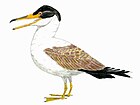Pedopenna: Difference between revisions
Chaotic Enby (talk | contribs) |
No edit summary |
||
| Line 4: | Line 4: | ||
| image_caption = Reconstruction as an anchiornithid |
| image_caption = Reconstruction as an anchiornithid |
||
| name = ''Pedopenna'' |
| name = ''Pedopenna'' |
||
| fossil_range = [[ |
| fossil_range = [[Late Jurassic]], {{fossilrange|164|earliest=168|latest=160}} |
||
| display_parents = 3 |
| display_parents = 3 |
||
| genus = Pedopenna |
| genus = Pedopenna |
||
Revision as of 17:13, 13 June 2023
| Pedopenna Temporal range: Late Jurassic,
| |
|---|---|

| |
| Reconstruction as an anchiornithid | |
| Scientific classification | |
| Domain: | Eukaryota |
| Kingdom: | Animalia |
| Phylum: | Chordata |
| Clade: | Dinosauria |
| Clade: | Saurischia |
| Clade: | Theropoda |
| Clade: | Paraves |
| Family: | †Anchiornithidae |
| Genus: | †Pedopenna Xu & Zhang, 2005 |
| Species: | †P. daohugouensis
|
| Binomial name | |
| †Pedopenna daohugouensis Xu & Zhang, 2005
| |
Pedopenna (meaning "foot feather") is a genus of small, feathered, maniraptoran dinosaur from the Daohugou Beds in China. It is possibly older than Archaeopteryx, though the age of the Daohugou Beds where it was found is debated. A majority of studies suggest that beds probably date from between the late Middle Jurassic (168 million years ago) and early Late Jurassic Period (164-152 million years ago).[1]
The name Pedopenna refers to the long pennaceous feathers on the metatarsus; daohugouensis refers to the locality of Daohugou, where the holotype was found.[2] Pedopenna daohugouensis probably measured 1 meter (3 ft) or less in length, but since this species is only known from the hind legs, the actual length is difficult to estimate. Pedopenna was originally classified as a paravian, the group of maniraptoran dinosaurs that includes both deinonychosaurs and avialans (the lineage including modern birds), but some scientists have classified it as a true avialan more closely related to modern birds than to deinonychosaurs.[3] More recently, it has been recovered as a scansoriopterygid.[4]
Description
The feet of Pedopenna resembled those of the related troodontids and dromaeosaurids (which together form the group Deinonychosauria), though were overall more primitive. In particular, the second toe of Pedopenna was not as specialized as in deinonychosaurs. While Pedopenna did have an enlarged claw and slightly shortened second toe, it was not as highly developed as the strongly curved, sickle-like claws of its relatives.[2]
Xu Xing and Zhang Fucheng, who interpreted the Daohugou fossil beds where Pedopenna was found as mid to late Jurassic in age, used the presence of such a primitive member of the avian lineage, in combination with many primitive members of closely related lineages there, to support the idea that birds originated in Asia.[2]
Feathers
The bird-like characteristics of Pedopenna are further evidence of the dinosaur-bird evolutionary relationship. Apart from having a very bird-like skeletal structure in its legs, Pedopenna was remarkable due to the presence of long pennaceous feathers on the metatarsus (foot). Some deinonychosaurs are also known to have these 'hind wings', but those of Pedopenna differ from those of animals like Microraptor. Pedopenna hind wings were smaller and more rounded in shape. The longest feathers were slightly shorter than the metatarsus, at about 55 mm (2 in) long. Additionally, the feathers of Pedopenna were symmetrical, unlike the asymmetrical feathers of some deinonychosaurs and birds. Since asymmetrical feathers are typical of animals adapted to flying, it is likely that Pedopenna represents an early stage in the development of these structures. While many of the feather impressions in the fossil are weak, it is clear that each possessed a rachis and barbs, and while the exact number of foot feathers is uncertain, they are more numerous than in the hind-wings of Microraptor. Pedopenna also shows evidence of shorter feathers overlying the long foot feathers, evidence for the presence of coverts as seen in modern birds. Since the feathers show fewer aerodynamic adaptations than the similar hind wings of Microraptor, and appear to be less stiff, suggests that if they did have some kind of aerodynamic function, it was much weaker than in deinonychosaurs and birds.[citation needed]
Xu and Zhang, in their 2005 description of Pedopenna, suggested that the feathers could be ornamental, or even vestigial. It is possible that a hind wing was present in the ancestors of deinonychosaurs and birds, and later lost in the bird lineage, with Pedopenna representing an intermediate stage where the hind wings are being reduced from a functional gliding apparatus to a display or insulatory function.[2] this theory may be confirmed by the discovery of Serikornis in 2017, an anchiornithid with soft, symmetrical feathers and filaments on parts of the body that were similar to Pedopenna's.
References
- ^ Liu Y.; Liu Y.; Ji S.; Yang Z. (2006). "U-Pb zircon age for the Daohugou Biota at Ningcheng of Inner Mongolia and comments on related issues". Chinese Science Bulletin. 51 (21): 2634–2644. Bibcode:2006ChSBu..51.2634L. doi:10.1007/s11434-006-2165-2. S2CID 96442710.
- ^ a b c d Xu, X. & Zhang, F. (2005). "A new maniraptoran dinosaur from China with long feathers on the metatarsus". Naturwissenschaften. 92 (4): 173–177. Bibcode:2005NW.....92..173X. doi:10.1007/s00114-004-0604-y. PMID 15685441. S2CID 789908.
- ^ Hone D.W.E.; Tischlinger H.; Xu X.; Zhang F. (2010). Farke, Andrew Allen (ed.). "The extent of the preserved feathers on the four-winged dinosaur Microraptor gui under ultraviolet light". PLOS ONE. 5 (2): e9223. Bibcode:2010PLoSO...5.9223H. doi:10.1371/journal.pone.0009223. PMC 2821398. PMID 20169153.
- ^ Hartman, Scott; Mortimer, Mickey; Wahl, William R.; Lomax, Dean R.; Lippincott, Jessica; Lovelace, David M. (2019). "A new paravian dinosaur from the Late Jurassic of North America supports a late acquisition of avian flight". PeerJ. 7: e7247. doi:10.7717/peerj.7247. PMC 6626525. PMID 31333906.










